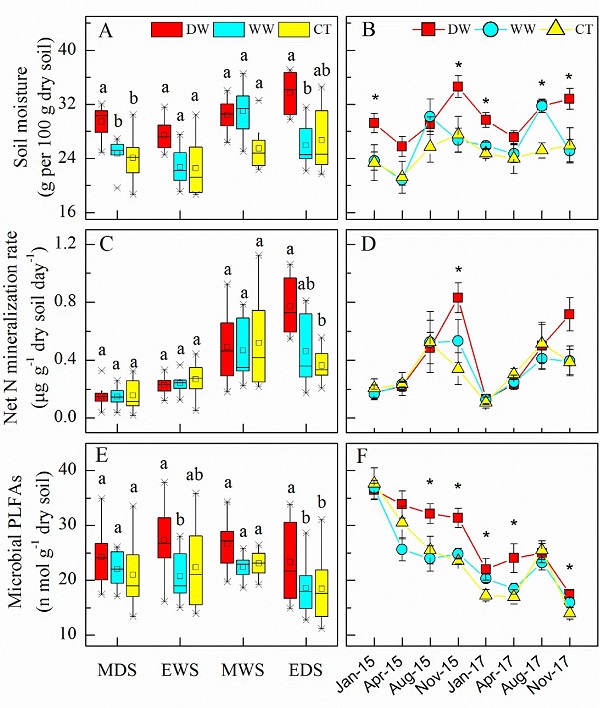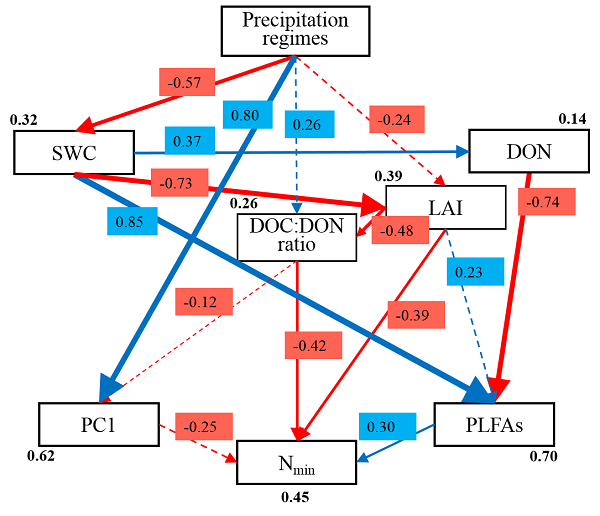

Seasonal precipitation regime plays a vital role in regulating nutrient dynamics in seasonally dry tropical forests. Present evidence suggests that not only wet season precipitation is increasing in the tropics of South China, but also that the wet season is occurring later. However, it is unclear how nutrient dynamics will respond to the projected precipitation regime changes.
Under the guidance of Professor Wang faming, Yu Shiqin, a doctoral student of the Soil Ecology and Ecological Engineering Research Group in South China Botanical Garden, carried out experiments to assesse the impacts of altered seasonal precipitation on soil net N mineralization in a secondary tropical forest in Xiaoliang Research Station of Tropical Coastal Ecosystems, Chinese Academy of Sciences. Since 2013, by reducing throughfall and/or irrigating experimental plots, we delayed the wet season by two months from April - September to June - November (DW treatment) or increased mean annual precipitation by 25% in July and August (WW treatment). We measured soil net N mineralization rates and assessed soil microbial communities in January, April, August and November in 2015 and 2017 (Fig. 1). We found that a wetter wet season did not significantly affect soil microbes or net N mineralization rates, even in the mid-wet season (August) when soil water content in the WW treatment increased significantly. By contrast, a delayed wet season enhanced soil microbial biomass and altered microbial community structure, resulting in a two-fold increase in net N mineralization rates relative to controls in the early dry season (November). Structural equation modeling showed that the changes in net N mineralization during the early dry season were associated with altered soil microbial communities, dissolved organic N, and litterfall, which were all affected by enhanced soil water content (Fig. 2). Our findings suggest that a delayed wet season could have a greater impact on N dynamics than increased precipitation during the wet season. Changes in the seasonal timing of rainfall might therefore influence the functioning of seasonally dry tropical forests.
The results were recently published in the international academic journal Science of the total environment (if = 7.963). Yu Shiqin is the first author and Prof. Wang faming is the corresponding author. Article link: https://doi.org/10.1016/j.scitotenv.2022.153314

Figure 1 The influence of precipitation manipulation treatments on (A, B) gravimetric soil water content, (C, D) soil net Nmin rate, and (E, F) microbial biomass (total PLFA content) during seasonal periods (A, C, E) and at eight sampling timepoints (B, D, F) and in a seasonally dry tropical forest; treatments are delayed wet season (DW) or a wetter wet season (WW) and controls (CT). Seasonal periods are mid-dry season (MDS), early wet season (EWS), mid-wet season (MWS) and early dry season (EDS). Boxplots with means (squares) are shown for n = 8 (A, C, E) per treatment, and means (symbols) ± standard errors are shown for n = 4 (B, D, F). Asterisks and different letters represent statistically significant differences at α = 0.05.

Figure 2 Final structural equation model (SEM) showing how changing precipitation regimes affect soil net N mineralization in the early dry season. Numbers next to arrows indicate the standardized parameter for each path. Squared multiple correlations for each predictor variable are shown in bold next to boxes. Solid arrows indicate significant paths at p < 0.05, and dashed lines are non-significant paths (p ≥ 0.05) retained in the best fit model. SWC is soil water content; DON is dissolved organic N; DOC:DON ratio is the ratio of DOC to DON; NO3--N is nitrate-N; LAI is forest canopy leaf area index; PC1 is the first principle component representing microbial community composition; PLFAs is total phospholipid fatty acids representing soil microbial biomass; Nmin is soil net N mineralization.

